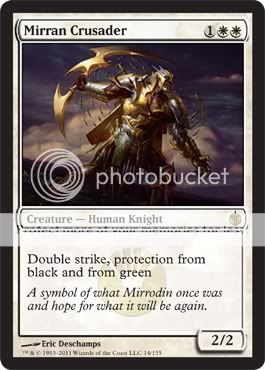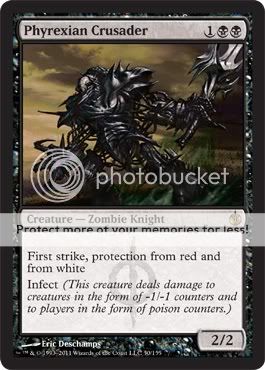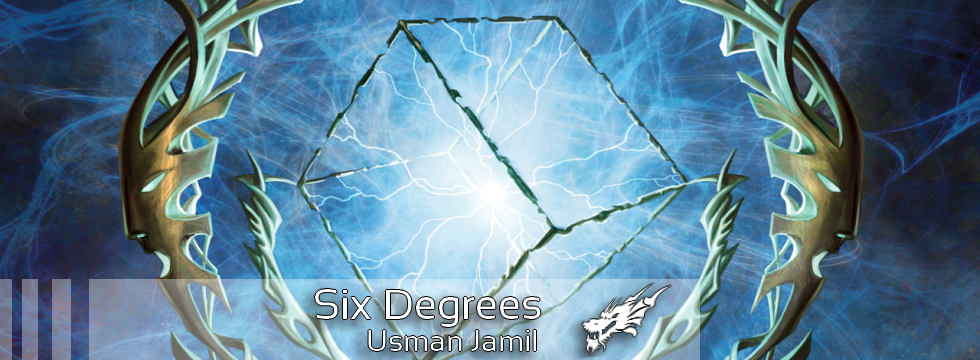Are you a Quiet Speculation member?
If not, now is a perfect time to join up! Our powerful tools, breaking-news analysis, and exclusive Discord channel will make sure you stay up to date and ahead of the curve.
A few weeks ago, I talked about how to use different resources like the MTGSalvation Cube Comparison thread and card databases like Gatherer to find cards for your cube.
However, I didn't talk about a subset of cards that's particularly relevant right now. Pierce Strider and Peace Strider were the first unveiled cards from Mirrodin Besieged, but they weren't very good, at least for cubes. With the recent unveiling of Mirran Crusader and Phyrexian Crusader, we suddenly have some better Mirrodin Besieged material to work with and there's no better time than now to talk about how to evaluate newly spoiled cards.
I talked about using card context in my article on ManaNation but to summarize, even with hidden gems like Soltari Trooper, just about every Magic card in existence has some form of history with it with the card being used in some shape or form in the past. For example, Wild Dogs was used in aggro decks around Saga/Masques block, Teroh's Faithful was one of the most prominent white cards in Torment limited (which made you pretty fly if you forced it in draft.) I went into depth about how there's a correlation between a card's success in a format and its success in a cube, so I won't rehash that point, but I mention this because sometimes using a card's success can be a useful tool (if used carefully.)
But what about spoiled cards? There's no such history to draw from! Some cards are pretty easy to evaluate since they're pretty basic cards and they compare pretty easily to other similar cards. Grave Titan was a pretty easy card to evaluate when it came out in Magic 2011, 10 power for 6 mana is an amazing deal in cube and that's not too hard to figure out. It was easily more powerful than the non-Kokusho 6-mana black finishers like Visara, the Dreadful or Skeletal Vampire, throwing one of those out for Grave Titan is about as hard as it is for Uncle Phil to throw Jazzy Jeff out.
But other types of newly spoiled cards aren't so easy to evaluate for cube. Thankfully, the newly spoiled Mirran Crusader and Phyrexian Crusader represent both sides of that coin.
 |
 |
Let's first look at a simple card like Mirran Crusader.No one outside of R & D has gamed with Mirran Crusader so there aren't any limited rankings or standard deck techs that can be used to see if Mirran Crusader's being used to success, but that doesn't mean that the card can't be evaluated, right?
Mirran Crusader's double strike essentially gives it 4 power, which is pretty hard to come by for 3 mana (especially in white) and when it does happen, usually it's with a drawback (consider examples include cards like Skittering Horror, Arrogant Bloodlord, Spur Grappler, or Wake Thrasher). Mirran Crusader also compares really well to other existing cubeworthy 3-drops like Pianna, Nomad Captain, Soltari Champion, Spectral Procession (it's really a 3-drop creature, not a 6-mana sorcery) and the card that the crusader's riffing on, Paladin En-Vec. The crusader's protection from black helps it get around removal and its having protection from green is pretty useful too. Those who have cubed with Sword of Body and Mind can attest to that (although it's not as useful as pro-red because pro-red helps creatures dodge a lot of removal from Burst Lightning to Rolling Earthquake. While it could be be argued whether Mirran Crusader's better than cards like Spectral Procession, there's hardly a doubt that it's in the same league as those cards and that it should go in a cube because it compares very favorably with other white 3-drops.
Just like in my article on lessons learned with evaluating Grizzly Fate, I'm not merely saying "Mirran Crusader is really good, use it in your cube" but rather that comparing cards, even new ones, to other cards with similar functionality and casting cost. It's pretty easy to make comparisons for simplistic cards like Mirran Crusader. Bash, beat. Lather, rinse, repeat.
Phyrexian Crusader's a whole different beast... er, Zombie Knight.
I've mentioned several times in my writings that linear strategies in cube are more difficult to evaluate. Cards like Goblin Ringleader obviously aren't very good in cube because there isn't the required critical mass to make it good but cards like Stoneforge Mystic and Totem-Guide Hartebeest (in all-common cubes) typically do have the required critical mass required to make them work. I've lately warmed up to cards like the latter two, since in my early cube days I thought "Well, what good is Stoneforge without a toolbox? Then all you have is a Squire if you draw the 1 equipment. Oh joy!" I found that wasn't the case and that Stoneforge Mystic was usually able to find itself in decks with 2+ equipment without much trouble (and Hartebeest fetching up a Kirtar's Desire or a Pacifism is typically not a pretty sight for opposing decks.) Decks that can be carefully built around a toolbox card, like Stoneforge Mystic with a Basilisk Collar and Behemoth Sledge toolbox in Naya Lightsaber or a Time Spiral era deck with 2 Mystical Teachings and a toolbox of instants and cards with flash, but those (Mystic, Teachings) cards are still rock-solid even if they can't have the same toolboxes that made them constructed all-stars.
Phyrexian Crusader at first glance looks like one of those "good on its own, but better in linear decks" types of cards. It's a riff on Paladin En-Vec and that card's solid, after all. The problem is that this comparison method doesn't really work with Phyrexian Crusader since it having infect changes how the card works by a lot. Those who have drafted Scars of Mirrodin have learned that mixing poison damage and regular damage is generally not the best avenue to victorysince both sources of damage do not interact with one another. Phyrexian Crusader's having infect, therefore, is a big "drawback" since there are not any other good (at least, not good enough for a cube) infect cards.
While it's true that Phyrexian Crusader does get a huge boost from power-pumping cards like Bonesplitter like Mirran Crusader does, the important distinction is that Phyrexian Crusader is going to be on guard duty for the majority of the game since it requires 5 hits to have worth as an attacker (since if it attacks 4 times and dies, its 8 poison damage will have no impact), which is a lot to ask from a creature in a cube and even with something like a Bonesplitter, the Crusader requires 3 hits to kill an opponent. "Living the dream" with something like that, while nice, isn't going to happen most of the time. Phyrexian Crusader effectively reads like this in cube:
This isn't a terrible cube creature, but its having virtual defender doesn't make it outclass other 3 drops in its color like Mirran Crusader does. It looks like it'll be a good defensive creature for black control decks (another problem with equipment like Bonesplitter and Phyrexian Crusader is that typically they won't be used in the same deck) but I don't feel that it's better than options like Vampire Nighthawk and Hypnotic Specter because of its defensive nature, since it'll be spending a lot of its time hosing aggro decks (and rather well at that, since it insta-kills X/2s, dodges white, red and a lot of black removal, and can easily block 3/3s.) I could be wrong and the Crusader may make its way into my cube after some testing but I don't see Phyrexian Crusader coming into my cube right now.
The most important thing is to be realistic when evaluating newly spoiled cards for your cube. Many people initially dismissed cards like the level-up creatures from Rise of the Eldrazi because they compared cards like Kargan Dragonlord to Figure of Destiny. "You'll spend 4 red mana leveling it up and it'll die to a Disfigure in response. Spending 6 red mana for a 4/4 flier too, that's just awful. You can't even do it at the end of an opponent's turn. Unplayable!" While statements like these show understanding of the potential downfalls of the level mechanic, they aren't realistic with how often those kinds of scenarios actually play out. Sure, a leveled up Dragonlord can get Disfigured in response to its 4th activation, but how often is that actually going to happen? How much value did you get out of the card - did you really pay 6 red mana for a 4/4 flier by leveling it up or did it have value before dying?
When Æther Adept was spoiled, I saw people dismiss it as a terrible card because it had a cost of 1UU instead of 2U (like Man-o'-War.) Sure, Æther Adept's harder casting cost made it worse than the old jellyfish, but did that render it unplayable in cube? Of course not. Man-o'-War's value came from being a 3 mana 2/2 that bounced a creature. Despite the fact that Æther Adept was harder to cast, it lost little overall value since it was still a 3 mana 2/2 that bounced a creature, so Æther Adept worked well in cubes.
Exaggerating drawbacks and benefits of cards is unfortunately a pretty common occurrence in Magic discussion. After all, statements like these are unfortunately not uncommon to hear:
"Stillmoon Cavalier's a 3 mana 2/1, Death Grasp ends games. Obviously, Death Grasp is better."
"Jace the Mind Sculptor is terrible, it'll just die to Lightning Bolt after giving you a Brainstorm! Who wants to pay 4 mana for a sorcery-speed Brainstorm? Junk."
Having a truly analytical eye for evaluating cards is a particularly important skill set to possess when designing and maintaining a cube. It's even more important to have this skill when new cards are unveiled, since all of the card evaluation at that point is abstract until you test the card out. Testing a card definitely helps to alleviate this kind of polarized thinking for new cards: I used to think that Wretched Anurid would be a terrible card in my commons cube because it could potentially kill me, but testing the card helped prove that its drawback was much less severe than I initially thought. Myr Battlesphere's a more recent example; I initially dismissed it because it looked unimpressive but thinking about the card's overall value got me to testing it in a control deck shell and the Battlesphere performed wonderfully, thus earning a place in my cube.
It's easy to think of new cards in terms of "Best Case Scenario Mentality" and "Worst Case Scenario Mentality" but the truth always lies in the middle of these extremes. Kargan Dragonlord will sometimes die in response to being leveled via Disfigure/Swords to Plowshares/Burst Lightning, but that's not always going to happen. Even if there is a plethora of this kind of removal effect, the opponent isn't always going to have it and the overall probability of that kind of scenario happening isn't very high overall.
To quote the late Mitch Hedberg:
You know when you see an advertisement for a casino and they have a picture of a guy winning money? That's false advertising, because that happens the least. That's like if you're advertising a hamburger, they could show a guy choking. 'This is what happened once.'
New cards can be notoriously difficult to evaluate. Tarmogoyf was a junk rare until people figured out that it was an amazingly efficient creature. Inquest, a now defunct gaming magazine, infamously said that Necropotence was "the worst card in Ice Age" before the dreaded enchantment caused the "Black Summer" of 1996. Many people, myself included, initially thought that the Lorwyn planeswalkers were weak cards but we learned the error of our ways once the power of these cards became clearly known.
My hope is that this article will help you to avoid these kinds of mistakes, allowing you to be in on the ground floor of powerful cube cards right out of the gate.
As always, my cube blog’s at idratherbecubing.wordpress.com,
twitter’s at @UsmanTheRad
and my email’s at my twitter address + gmail.com!







I've had my cube for about a year and a half and I know the pain of what it's like to have to evaluate new sets and make changes to the cube. To be perfectly frank I thought this article was all over the place and felt a little…jittery. I couldn't get a real sense of what your point was and just when I thought you were getting to it, you would shift gears to some other side point. The references you made to your other articles could have been summed up in a sentence or two without having to further divert my attention from the current article.
I think you have a good subject here, but I didn't really get anything out of this other than a small review of the newly spoiled cards. You could have used more examples of some less conventional card choices from other sets – sleepers if you will. Since you've probably been doing this longer than me and many of the people reading this, why not tell use what it's been like to evaluate from other blocks? Hope this helps.
Thanks for the great article. It's so hard to analyze new cards when they come out, it's good to look at them from as many different perspectives as possible. I know when new sets come out I like to try out as many cards as I can. As someone who didn't play Magic in the way-back-then, I know how something that looks so terrible on paper can actually be an amazing card. Keep up the cube articles!
Super informative wtriing; keep it up.
You actually make it seem really easy with your presentation however I find this matter to be really
something that I think I’d never understand. It kind of feels too complex and very vast for me.
I am looking forward on your next put up, I will try to get the grasp of it!
Thanks iin favor of sharing such a fastidious thinking, article is fastidious, thats why i have read it completely
You’re so interesting! I do noot think I have read through something
lke that before. So nice to find anjother person with genuine thoughts on thhis subject matter.
Really.. thanks for starting this up. This web site is something that is
neeed on the internet, someone with some originality!
Great post. I was checking constantly this boog and I am impressed! I ccare for such information much.
I ccare for such information much.
Very helpful info specifically the last part
I was seeking this certain information for a long time.
Thank you and good luck.
Hey, Awesome website. I am looking forward to see more of your suff.